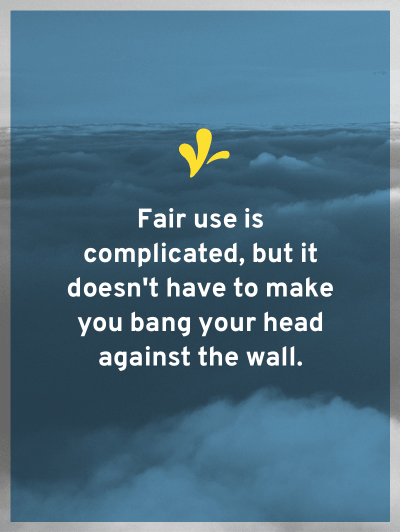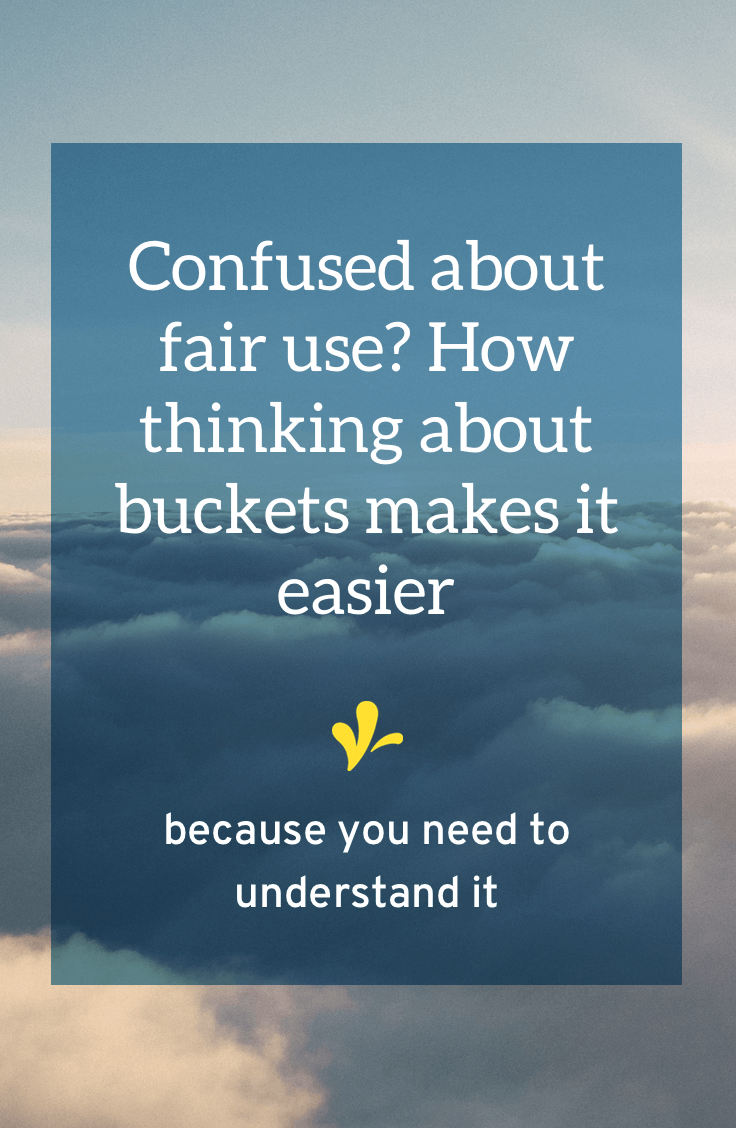If you’ve ever dug into copyright issues, I’m sure that you’ve heard of the term fair use. And I’m sure if you started to research it, you left that research session with a spinning head and more confused than when you began. This is because fair use is one of the most complicated copyright topics.
Why do we have fair use?
I’ve mentioned a couple times the importance of understanding public policy for laws. So why does fair use exist?
Fair use is an attempt to strike a balance between the rights of copyright owners and the rights of the public.

The rights of the copyright owners center on the idea that copyright owners should have a certain timeframe to exclusively exploit their work. This exclusive period gives them an incentive to create work.
On the flip side, the rights of the public are centered in the fact that they should have the right to use limited portions of copyrighted works for socially important uses. Traditionally, these uses include teaching, research, news reporting, parody, and criticism.
Is your use fair use?
As I mentioned in the opening, fair use is a complicated topic, and in complex situations it wouldn’t surprise me if you got three different answers from three different attorneys on whether something is or isn’t fair use. What’s even more frustrating is they all might come to the same answer, but in a different way. However, to get to this answer, each will be weighing the same four factors.
What are the fair use factors?
To determine if something is/isn’t fair use we want to examine:
- the purpose and character of the use, including whether such use is of a commercial nature or is for non-commercial purposes
- the nature of the copyrighted work
- the amount and substantiality of the portion used in relation to the copyrighted work as a whole
- the effect of the use upon the potential market for or value of the copyright
The bucket system
One way to think about fair use is to imagine a set of five buckets. Four of the buckets represent each of the factors above, are filled with liquid, and are all ~25% of the size of a larger bucket. If we decide that the factor leans towards fair use, the liquid stays in the factor bucket, if the factor leans towards copyright infringement then the liquid gets poured in the larger bucket.
If at the end the larger bucket is more than 50% full, then it might be copyright infringement, less than 50% probably fair use.
Just so we have a single word to use for each of the works we are looking at, I’m going to call the original work, the Original, and the work that incorporates the Original, the Incorporated.
The Purpose and Character of the Use
Judges have consistently determined that this first factor carries heavy weight in determining if something is fair use or not (AKA this factor is bigger than 25% of the large bucket). There are three things that we want to look at here:
- Did the Incorporated add new meaning to the work, thus transforming the Original to something else?
- Did the Incorporated add value to the Original by adding new information, insights, or understandings?
- Was the Incorporated created for one of the socially important purposes, not a commercial profit?
If the Incorporated work can answer, “yes” to one or more of the above questions, then it’s likely fair use and we won’t add liquid to our larger bucket. If the answer is “no,” then we should add this liquid into our larger bucket.
The Nature of the Copyrighted Work
One of the underlying principles of copyright law is that you cannot copyright facts. Because of this, this factor considers what factual information if any, was included in the Original and the Incorporated work.
If the Incorporated work only takes factual information, then it’s likely fair use and we won’t add liquid to the larger bucket. If it takes the creative portions of the Original, then we should add this liquid into our larger bucket.
The Amount and Substantiality of the Portion Used
This factor is where the Internet wisdom that you can take up to 5% of something and be safe comes from. However, this is not always the case. It is true that the less you take, the more likely something will be considered fair use. But if you take a small part of something and it is the “core” of the Original, then you are not safe.
If the Incorporated work only takes a small amount of the Original (and not the “core”), then it’s likely fair use and we won’t add liquid to the larger bucket. If it takes the core of the Original or a substantial portion, then we should add this liquid into our larger bucket.
The Effect on the Artist’s Market
The final factor also often gets more than an exact 25% of our large bucket. This factor looks at whether the Incorporated work undermines the earning potential of the Original. There doesn’t have to be direct competition here, it could be that the Incorporated undermines the potential for a market for the Original.
If the Incorporated work doesn’t reduce the earning potential of the Original, then it’s likely fair use and we won’t add liquid to the larger bucket. If it takes away from the market for the Original, then we should add this liquid into our larger bucket.
Deciding if it’s fair use
The goal here is to examine each of these factors and determine if we add liquid to the larger bucket. If the larger bucket ends up more than 50% full, then it might be copyright infringement, less than 50% probably fair use. This can be a pretty complex decision; so don’t be afraid to reach out to an attorney who focuses on copyright law to double check your answers.
Fair Use is usually used as a defense
Fair use of someone else’s copyrighted works is not copyright infringement. That being said, determining if something is fair use or not, most often arises as a defense to a copyright infringement lawsuit (or threatened lawsuit). The person who used the work without permission admits to the use, but their actions are acceptable because they were within the bounds of fair use.
The takeaway: fair use will not prevent you from being sued for copyright infringement, but if your actions are found to be fair use, you did not commit copyright infringement.
Does that help you understand what is and isn’t fair use? Let me know your thoughts and questions in the comments below.

Hi! I’m Kiff! I believe that you can have ease in the legalese of running your creative business.
Each week, I send out an email to help you confidently strengthen your business’ legal foundation by sharing my experiences and knowledge.
Get tips from your friendly legal eagle…
Your privacy is important to us. Learn how we protect it here.


